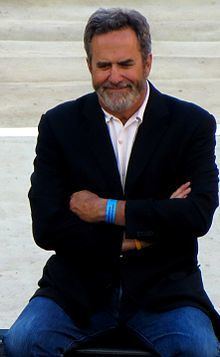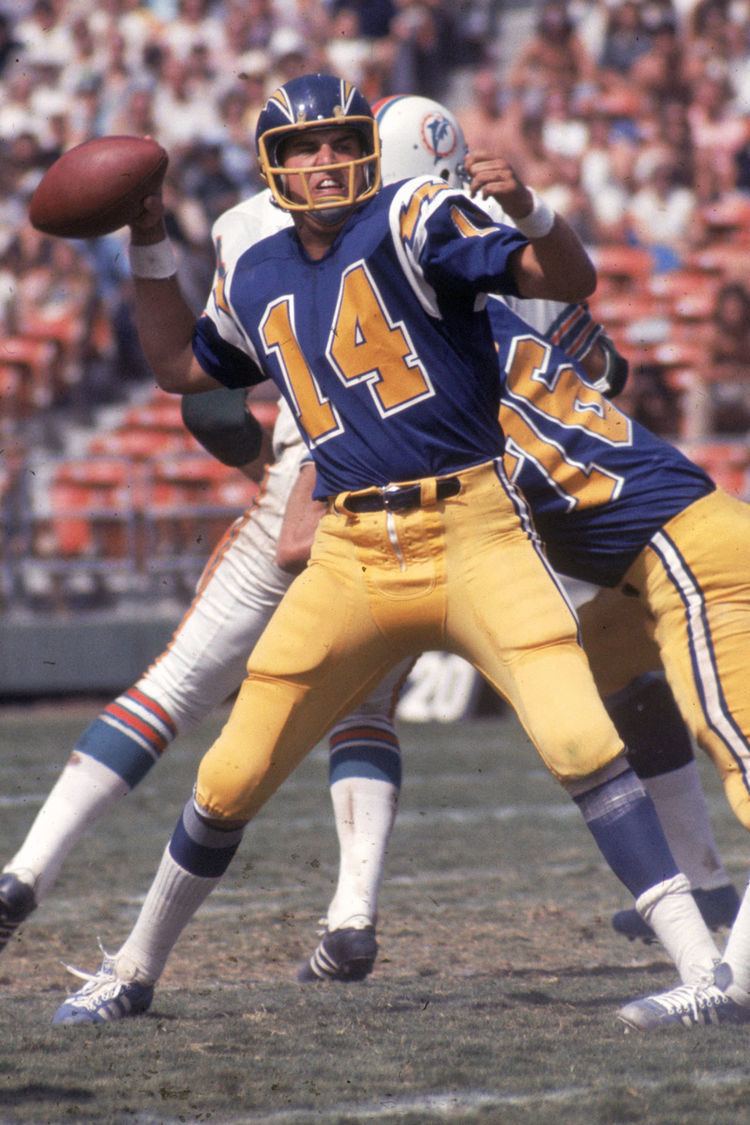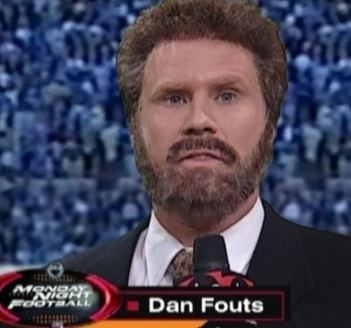Position: Quarterback Parents Bob Fouts Height: 6 ft 3 in (1.91 m) Spouse Jeri Martin | Weight: 204 lb (93 kg) Name Dan Fouts | |
 | ||
Date of birth: (1951-06-10) June 10, 1951 (age 64) High school: San Francisco (CA) St. Ignatius College Prep Children Dominic, Shannon Fouts, Suzanne Krueger Siblings Nancy Fouts, Bob Fouts, John Fouts, Patty Fouts Similar People | ||
Dan fouts highlights san diego chargers
Daniel Francis Fouts (born June 10, 1951) is a former American football quarterback who played in the National Football League (NFL). Fouts played his entire professional career with the San Diego Chargers from 1973 through 1987. He was one of the most prolific passing quarterbacks during the 1970s and 1980s, but the Chargers were unable to make it to the Super Bowl during his fifteen-year career. He led the NFL in passing yards four straight years from 1979 to 1982, and became the first player in history to throw for 4,000 yards in three consecutive seasons.
Contents
- Dan fouts highlights san diego chargers
- Good Morning Football HOF QB Dan Fouts On Philip Rivers Chargers Season
- High school and college career
- Professional career
- Honors
- Chargers Franchise Records
- Broadcasting
- References

He was inducted into the Pro Football Hall of Fame in 1993. He is currently a color analyst for NFL games on CBS television and Dial Global radio. Dan is the son of Bay Area Radio Hall of Famer Bob Fouts.

Good Morning Football: HOF QB Dan Fouts On Philip Rivers; Chargers Season
High school and college career

Fouts was born in San Francisco, California. He went to Marin Catholic High School, which is located just north of San Francisco in Kentfield, California for his two first years of High School, and was starting for the varsity team by his sophomore year. He decided to transfer to St. Ignatius College Preparatory (San Francisco, CA) for his final two years of high school.

Fouts was somewhat of an unknown when he accepted a scholarship offer from the University of Oregon to play for the Oregon Ducks football team. Things were quite different after the All-Pac-8 quarterback's career where he set 19 school records, including those for career passing yardage (5,995) and total offense (5,871). He was inducted into the University of Oregon Hall of Fame in 1992.

Professional career
Drafted in the third round in 1973, Fouts helped lead the Chargers to the playoffs from 1979 to 1982 and twice to the AFC title game (1980 and 1981). He led the league four times in passing yards; ending his career with over 40,000, the third player to surpass that landmark. Fouts was elected to the Pro Football Hall of Fame in 1993.
Fouts was a 6-time Pro Bowl selection (1979, 1980, 1981, 1982, 1983 and 1985) and compiled passer ratings over 90.0 for a 3-year stretch (1981–83). Fouts was the first NFL player to surpass 4,000 passing yards and would go on to accomplish this in three consecutive seasons (1979–81), led the NFL in passing yards in four consecutive seasons (1979–1982) and six times eclipsed the 20-touchdown mark with a career-high 33 in 1981. His career high of 4,802 passing yards during the 1981 season was an NFL record at the time.
Fouts set NFL season passing yardage records in three consecutive seasons from 1979 to 1981 with totals of 4,082, 4,715, and 4,802 yards. He broke Joe Namath's professional record of 4,007 set in the American Football League in 1967, and Dan Marino broke Fouts' record in 1984 with 5,084 yards. The Chargers in 1979 were the first AFC Western Division champion to run more passing plays (541) than rushing (481). In 1982, a season shortened to 9 games because of a strike, Fouts averaged 320 yards passing per game, an NFL record that stood until Drew Brees averaged 342.25 in 2011. (The current record is 342.31, set by Peyton Manning in 2013.) Highlights that season included back-to-back victories against the 1981 Super Bowl teams San Francisco (41-37) and Cincinnati (50-34) in which Fouts threw for over 400 yards in each game to lead the Chargers to shootout victories. That season, he was named the NFL's Most Valuable Player by Pro Football Writers Association and Newspaper Enterprise Association. He finished second in the Associated Press poll behind Mark Moseley, the only kicker to ever win the award. However, AP voted him the league's Offensive MVP, as did Pro Football Weekly.
Fouts garnered All-Pro selections in both 1979 and 1982, while also being named 2nd Team All-Pro in 1980 and 1985. In addition Fouts was also named 2nd Team All-AFC in 1981 and 1983. However, Fouts and the Chargers lost both AFC Championship Games in which they played.
Fouts's first few years in the league were inauspicious, but with the arrival of head coach Don Coryell in 1978 the Chargers' fortunes turned. Yet it was two years earlier, with the arrival of Bill Walsh as the Chargers' offensive coordinator, that the seeds of success were planted. Under Coryell, the Chargers were known as Air Coryell for the deep passing game and the involvement of the tight end as a key receiver. This required a tough, intelligent quarterback with a strong arm. Fouts fit the bill.
Fouts was not a mobile quarterback and the deep passing game led to many hits. Hall of Fame coach Bill Walsh, a Chargers assistant coach in 1976, said "Dan Fouts had a cool, steel-like nerve and courage ... He took a lot of beatings, a lot of pounding, but continued to play, hurt or otherwise. He played more physical football than anybody on his team, including the linebackers". Rarely using the shotgun, Fouts would drop back from center and look for one of a bevy of great receivers. Wide receiver Charlie Joiner and tight end Kellen Winslow were the most famous, both now in the Hall of Fame, but John Jefferson and Wes Chandler, among others, were also key. Fouts's passing enabled Winslow to lead the NFL in receptions twice (1980,1981), while Winslow (1982) and Lionel James (1985) led the AFC in receptions on another 2 combined occasions. James, in fact, set the NFL record (since broken) in 1985 for receiving yards by a running back at 1,027. Jefferson became the first receiver to have 1,000 yards receiving in each of his first three seasons in the NFL. Both Jefferson (1980) and Chandler (1982) led the NFL in receiving yards. Chandler's 129 yards receiving per game average in 1982 is still a league record. Both Jefferson (1978, 1980) and Chandler (1982) led the NFL in receiving TDs. In 1980, Winslow, Jefferson and Joiner became the first trio on the same team to have 1,000 yards receiving in a season. When he retired after 1986, Joiner was the NFL's all-time leader in receptions with 750.
Pass protection was also critical for such an offense. The Chargers had an excellent offensive line which protected Fouts well, and included four-time Pro Bowler Ed White, five-time Pro Bowler Russ Washington, 3 time Pro Bowler Doug Wilkerson, Billy Shields and Don Macek. The Chargers led the league in passing yards an NFL record 6 consecutive years from 1978–1983 and again in 1985 under Fouts. They also led the league in total yards in offense 1980-1983 and 1985.
Despite going to the playoffs from 1979 through 1982 and playing in two AFC Championship Games, the Chargers never went to the Super Bowl under Fouts (although they went 7 years after his retirement). Usually this is attributed to poor defense and their unwillingness to run the ball. In Fouts's prime the defense was not as stellar, but the running game became far better with the addition of Chuck Muncie, traded from New Orleans in 1980, and the drafting of James Brooks from Auburn in 1981. It is believed the defense had little opportunity to improve as the offense often scored quickly, leaving the defense to spend far too much time on the field. It also hurt that Fred Dean, an All-Pro sack specialist, was traded away to the San Francisco 49ers in 1981 in a contract dispute, and Dean would win UPI NFC Defensive Player of the Year (while playing in only 11 games) that year en route to a Super Bowl victory and help the 49ers to another Super Bowl title three years later. Dean would later be inducted into the Hall of Fame.
"I can't say how much it affected us, because we did make it to the AFC championship game," said Chargers' All-Pro defensive lineman Gary "Big Hands" Johnson of the loss of Dean. "But I could say if we had more pass rush from the corner, it might've been different." U-T San Diego in 2013 called the trade "perhaps the biggest blunder in franchise history." Fouts himself would almost be traded in 1983 to the Baltimore Colts in exchange for the rights to John Elway due to a contract dispute, but would come to an agreement on an extension and Elway would be infamously traded to the rival Denver Broncos instead.
Overall, the Chargers achieved three wins against four losses in the playoffs under Fouts, who threw for over 300 yards in all but two of those games. One of their more notable wins was the 1982 playoff game known in NFL Lore as The Epic in Miami, where Fouts led his team to a 41–38 victory by completing 33 of 53 passes for a franchise record 433 yards and 3 touchdowns on the hot and humid day. His completions, attempts, and yards in the game were all NFL postseason records at the time. The following week in the AFC championship game in Cincinnati, there was a 92 °F drop in temperature compared to the previous week in Miami, and the Chargers lost 27-7 in what is known as the Freezer Bowl.
The following season, he threw for 333 yards and 3 touchdowns in a 31–28 win over the Pittsburgh Steelers in the AFC Wild Card round. Fouts's playoff career ended in the AFC Divisional Playoff game against Miami, where he threw 5 interceptions to only one touchdown pass. Fouts went on to play for four other seasons with the Chargers, retiring in 1987 after 15 years with them. He ended his career as the Chargers' all-time leader in passing yard and touchdowns with 43,040 and 254 respectively.
Honors
Fouts finished his 15 NFL seasons with 3,297 of 5,604 completions for 43,040 yards and 254 touchdowns, with 242 interceptions. He also rushed for 476 yards and 13 touchdowns
Fouts is one of only ten quarterbacks in NFL history who have achieved two consecutive 30-touchdown passing seasons. The others are Steve Bartkowski, Aaron Rodgers, Brett Favre, Dan Marino, Jeff Garcia, Tom Brady, Peyton Manning, Drew Brees, and Y. A. Tittle. He was also the third quarterback in NFL history to pass for 40,000 yards, after fellow Hall of Famers Johnny Unitas and Fran Tarkenton, and the first quarterback ever to throw for over 4,000 yards in back-to-back seasons.
Fouts's jersey number, 14, is one of only four numbers retired by the San Diego Chargers (the others being Lance Alworth's 19, Junior Seau's 55 and LaDainian Tomlinson's 21).
In 1989, Fouts was also inducted by the San Diego Hall of Champions into the Breitbard Hall of Fame honoring San Diego's finest athletes both on and off the playing surface.
In 1999, he was ranked number 92 on The Sporting News' list of the 100 Greatest Football Players.
In 1992, he was inducted into the University of Oregon and State of Oregon Sports Halls of Fame.
Fouts was enshrined into the Pro Football Hall of Fame in 1993, his first year of eligibility.
In 2009, he was picked by the fans as the "Greatest Charger Of All Time" for the Chargers 50th anniversary year.
In 2010, he received the Davey O'Brien Legends Award during Colt McCoy's award ceremony.
Chargers Franchise Records
Broadcasting
In 1988 through 1993, Fouts started his career as an analyst on NFL on CBS. He worked with a variety of play-by-play announcers including Dick Stockton, James Brown, Verne Lundquist, Brad Nessler, Jim Nantz, Jack Buck, and Tim Ryan.
Fouts left CBS in 1994 to become a sports anchor for KPIX-TV in his hometown of San Francisco. In the fall of 1997, Fouts returned to network television as analyst, this time serving as a college football analyst for ABC Sports alongside play-by-play man Brent Musburger.
In 1998 Fouts made his big-screen debut, portraying himself in the football comedy The Waterboy, starring Adam Sandler. Fouts and Musburger appeared late in the film as ABC Sports' broadcast team for the fictitious New Year's Day "Bourbon Bowl" game.
In 2000, Fouts moved into a commentator role on ABC's Monday Night Football, alongside MNF anchor Al Michaels and comedian Dennis Miller.
In 2002, Fouts returned to broadcasting college football, calling Pac 10 action alongside legendary announcer Keith Jackson.
After Jackson's retirement from ABC in 2006, Fouts became a play-by-play announcer, adding his own commentary on the game at times since he was a former player and analyst. His broadcast partner for 2006 and 2007 was Tim Brant, now that Jackson opted to permanently retire.
On February 11, 2008, ESPN announced they weren't re-signing Fouts or his partner Tim Brant.
It was reported in USA Today on August 20, 2008, that Fouts was returning to CBS for NFL games with a variety of play-by-play announcers including Don Criqui, Ian Eagle, and Dick Enberg. In 2009, he was moved to partner with Enberg as the number 3 broadcasting team for the NFL on CBS. Fouts has since teamed with Eagle in the number three slot until 2014, when the pair was elevated to the number two team behind Jim Nantz and Phil Simms. Fouts and Eagle are often called "The Bird and the Beard".
Fouts has also helped call NFL games for Westwood One radio, including Super Bowl 50.
Since 2012, he has been the play-by-play voice for Chargers preseason games carried on CBS stations throughout Southern California, alongside fellow Charger alum Billy Ray Smith.
Fouts also did color commentary for the football video game NFL GameDay 2004. He partnered with long-time announcer Enberg.
